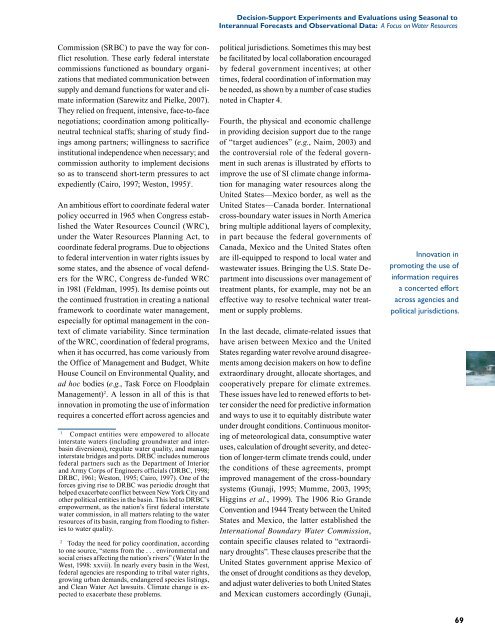Decision support experiments and evaluations using seasonal to ...
Decision support experiments and evaluations using seasonal to ...
Decision support experiments and evaluations using seasonal to ...
You also want an ePaper? Increase the reach of your titles
YUMPU automatically turns print PDFs into web optimized ePapers that Google loves.
Commission (SRBC) <strong>to</strong> pave the way for conflict<br />
resolution. These early federal interstate<br />
commissions functioned as boundary organizations<br />
that mediated communication between<br />
supply <strong>and</strong> dem<strong>and</strong> functions for water <strong>and</strong> climate<br />
information (Sarewitz <strong>and</strong> Pielke, 2007).<br />
They relied on frequent, intensive, face-<strong>to</strong>-face<br />
negotiations; coordination among politicallyneutral<br />
technical staffs; sharing of study findings<br />
among partners; willingness <strong>to</strong> sacrifice<br />
institutional independence when necessary; <strong>and</strong><br />
commission authority <strong>to</strong> implement decisions<br />
so as <strong>to</strong> transcend short-term pressures <strong>to</strong> act<br />
expediently (Cairo, 1997; Wes<strong>to</strong>n, 1995) 1 .<br />
An ambitious effort <strong>to</strong> coordinate federal water<br />
policy occurred in 1965 when Congress established<br />
the Water Resources Council (WRC),<br />
under the Water Resources Planning Act, <strong>to</strong><br />
coordinate federal programs. Due <strong>to</strong> objections<br />
<strong>to</strong> federal intervention in water rights issues by<br />
some states, <strong>and</strong> the absence of vocal defenders<br />
for the WRC, Congress de-funded WRC<br />
in 1981 (Feldman, 1995). Its demise points out<br />
the continued frustration in creating a national<br />
framework <strong>to</strong> coordinate water management,<br />
especially for optimal management in the context<br />
of climate variability. Since termination<br />
of the WRC, coordination of federal programs,<br />
when it has occurred, has come variously from<br />
the Office of Management <strong>and</strong> Budget, White<br />
House Council on Environmental Quality, <strong>and</strong><br />
ad hoc bodies (e.g., Task Force on Floodplain<br />
Management) 2 . A lesson in all of this is that<br />
innovation in promoting the use of information<br />
requires a concerted effort across agencies <strong>and</strong><br />
1 Compact entities were empowered <strong>to</strong> allocate<br />
interstate waters (including groundwater <strong>and</strong> interbasin<br />
diversions), regulate water quality, <strong>and</strong> manage<br />
interstate bridges <strong>and</strong> ports. DRBC includes numerous<br />
federal partners such as the Department of Interior<br />
<strong>and</strong> Army Corps of Engineers officials (DRBC, 1998;<br />
DRBC, 1961; Wes<strong>to</strong>n, 1995; Cairo, 1997). One of the<br />
forces giving rise <strong>to</strong> DRBC was periodic drought that<br />
helped exacerbate conflict between New York City <strong>and</strong><br />
other political entities in the basin. This led <strong>to</strong> DRBC’s<br />
empowerment, as the nation’s first federal interstate<br />
water commission, in all matters relating <strong>to</strong> the water<br />
resources of its basin, ranging from flooding <strong>to</strong> fisheries<br />
<strong>to</strong> water quality.<br />
2 Today the need for policy coordination, according<br />
<strong>to</strong> one source, “stems from the . . . environmental <strong>and</strong><br />
social crises affecting the nation’s rivers” (Water In the<br />
West, 1998: xxvii). In nearly every basin in the West,<br />
federal agencies are responding <strong>to</strong> tribal water rights,<br />
growing urban dem<strong>and</strong>s, endangered species listings,<br />
<strong>and</strong> Clean Water Act lawsuits. Climate change is expected<br />
<strong>to</strong> exacerbate these problems.<br />
<strong>Decision</strong>-Support Experiments <strong>and</strong> Evaluations <strong>using</strong> Seasonal <strong>to</strong><br />
Interannual Forecasts <strong>and</strong> Observational Data: A Focus on Water Resources<br />
political jurisdictions. Sometimes this may best<br />
be facilitated by local collaboration encouraged<br />
by federal government incentives; at other<br />
times, federal coordination of information may<br />
be needed, as shown by a number of case studies<br />
noted in Chapter 4.<br />
Fourth, the physical <strong>and</strong> economic challenge<br />
in providing decision <strong>support</strong> due <strong>to</strong> the range<br />
of “target audiences” (e.g., Naim, 2003) <strong>and</strong><br />
the controversial role of the federal government<br />
in such arenas is illustrated by efforts <strong>to</strong><br />
improve the use of SI climate change information<br />
for managing water resources along the<br />
United States—Mexico border, as well as the<br />
United States—Canada border. International<br />
cross-boundary water issues in North America<br />
bring multiple additional layers of complexity,<br />
in part because the federal governments of<br />
Canada, Mexico <strong>and</strong> the United States often<br />
are ill-equipped <strong>to</strong> respond <strong>to</strong> local water <strong>and</strong><br />
wastewater issues. Bringing the U.S. State Department<br />
in<strong>to</strong> discussions over management of<br />
treatment plants, for example, may not be an<br />
effective way <strong>to</strong> resolve technical water treatment<br />
or supply problems.<br />
In the last decade, climate-related issues that<br />
have arisen between Mexico <strong>and</strong> the United<br />
States regarding water revolve around disagreements<br />
among decision makers on how <strong>to</strong> define<br />
extraordinary drought, allocate shortages, <strong>and</strong><br />
cooperatively prepare for climate extremes.<br />
These issues have led <strong>to</strong> renewed efforts <strong>to</strong> better<br />
consider the need for predictive information<br />
<strong>and</strong> ways <strong>to</strong> use it <strong>to</strong> equitably distribute water<br />
under drought conditions. Continuous moni<strong>to</strong>ring<br />
of meteorological data, consumptive water<br />
uses, calculation of drought severity, <strong>and</strong> detection<br />
of longer-term climate trends could, under<br />
the conditions of these agreements, prompt<br />
improved management of the cross-boundary<br />
systems (Gunaji, 1995; Mumme, 2003, 1995;<br />
Higgins et al., 1999). The 1906 Rio Gr<strong>and</strong>e<br />
Convention <strong>and</strong> 1944 Treaty between the United<br />
States <strong>and</strong> Mexico, the latter established the<br />
International Boundary Water Commission,<br />
contain specific clauses related <strong>to</strong> “extraordinary<br />
droughts”. These clauses prescribe that the<br />
United States government apprise Mexico of<br />
the onset of drought conditions as they develop,<br />
<strong>and</strong> adjust water deliveries <strong>to</strong> both United States<br />
<strong>and</strong> Mexican cus<strong>to</strong>mers accordingly (Gunaji,<br />
Innovation in<br />
promoting the use of<br />
information requires<br />
a concerted effort<br />
across agencies <strong>and</strong><br />
political jurisdictions.<br />
69




